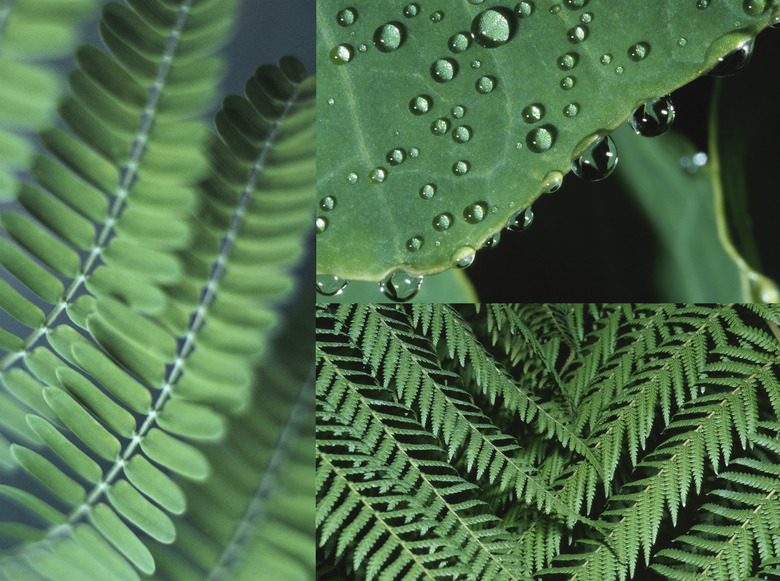Examples Of Non-Seed Plants
There are more than 390,000 types of living plants on Earth. Many plants you may recognize – such as trees and flowers – reproduce and multiply by making seeds. There are also many types of non-seed plants on Earth, including ferns, club mosses and a group of nonvascular plants known as bryophytes. Non-seed plant examples in the bryophyte group are mosses, liverworts and horsetails, which have been around since the time of the dinosaurs.
Ferns
Ferns
One group of plants that grow without seeds that may be the most familiar are ferns. Ferns have roots, stems and large, feathery leaves called fronds. There are thousands of different kinds of ferns all over the world, and in tropical forests some ferns can grow to be more than 65 feet (20 meters) high. In places where the temperature gets cold in the fall, the fern's leaves die, but the roots and stems are able to stay alive underground.
So how do plants reproduce if they can't make seeds? Plants that grow without seeds are able to create spores. Spore-containing plants have male shoots that make different reproductive cells and female shoots that make egg cells. Many spore-containing plants like ferns depend on the wind to carry their spores to new locations. Some ferns carry their spores on tall stalks like mosses, though others store them along their stems or in tiny pockets under their leaves.
Mosses
Mosses
Mosses are unique plants because they do not have true roots or stems. This is also why they do not grow very high up off of the forest floor. Mosses take up water and nutrients directly into their green leaflike parts, which means they usually grow in damp and shady habitats, like on trees and along streams.
Just like ferns and other types of bryophytes, mosses use spores for reproduction. Mosses need water so the male and female cells can join together to form a spore case. In mosses, a thin stalk carries the spore case, which holds millions of tiny spores. The wind carries spores away from the cases after they open, and each spore can grow a brand new moss plant.
Horsetails
Horsetails
Horsetails are plants with hollow, jointed stems. They are called "living fossils" because they have been around since the time of the dinosaurs more than 300 million years ago. At that time, horsetails were the size of trees, but they are much smaller today. Most horsetails grow no more than three feet (one meter) tall, though some are much shorter.
Horsetail stems grow underground, sending roots deeper into the soil and shoots up into the air. Spore-making shoots are pale brown. The other shoots are green and look like a horse's tail, which is where the plant gets its name. The green shoots have branching stems and tiny scales, which are the plant's leaves.
Liverworts
Liverworts
Liverworts are simple plants like mosses, which means they do not have true stems, roots or leaves. One of the most common kinds of liverworts looks like a small piece of lettuce on the ground. The plant's body is flat and grows along the ground, and because they do not have stems or roots, they live in damp, shady places such as along streams and on rocks and trees. Liverworts may have been the first type of plant to live on land. Scientists have found fossils of liverworts that are nearly 400 million years old.
Club Mosses
Club Mosses
Club mosses have roots, stems and leaves, which sets them apart from other mosses, even though they look similar at first glance. The roots are able to grow into the soil and soak up water and nutrients. The nutrients and water travel up the stem and out to the leaves, each of which only has one vein for this transportation.
Club mosses grow in many different places around the world. Some grow in tropical forests, in the northern boreal forest, or even under ice and snow. Some club mosses carry their spores in shoots and look like small fir trees.
References
- The Hidden Forest: Moss Reproduction
- The Hidden Forest: Liverwort Reproduction
- Britannica Kids: Fern Life Cycle
- Australian National Botanic Gardens: What is a Liverwort?
- Oregon State: Basic Moss Biology
- Southern Illinois University: Bryophytes
- Virginia Native Plant Society: Clubmosses: An Ancient and Interesting Group of "Fern Allies"
- American Fern Society: About Ferns
Cite This Article
MLA
Taylor, Lindsey. "Examples Of Non-Seed Plants" sciencing.com, https://www.sciencing.com/examples-of-non-seed-plants-13428141/. 30 September 2021.
APA
Taylor, Lindsey. (2021, September 30). Examples Of Non-Seed Plants. sciencing.com. Retrieved from https://www.sciencing.com/examples-of-non-seed-plants-13428141/
Chicago
Taylor, Lindsey. Examples Of Non-Seed Plants last modified March 24, 2022. https://www.sciencing.com/examples-of-non-seed-plants-13428141/
